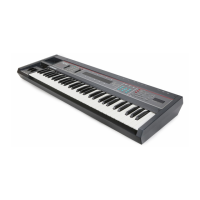SQ-80 — Musician's Manual
Press the "Soft" Button above the WAVE NAME. Now you can use the Data Entry Slider and the Up
and Down Arrow Buttons to change the Wave that OSC 1 will play. There are 75 available choices, each
with its own Name. Follow the same procedure to select a Wave for OSC 2 and OSC
3. The following
section details each Wave by Name.
Check Them Out
The best way to understand the SQ-80's Waves is not to read about them, but to hear them.
• Select an Internal Program. preferably one with infinite sustain such as an organ sound.
• Turn off the output of Oscillators 2 and 3 (Press the DCA2 button to select the Oscillator Volume
Page for Oscillator 2. Select the parameter OUTPUT=ON and switch it to OFF. Do the same on the
DCA3 Page).
Now select the OSC 1 Page as shown above, and select WAVE. Move the Data Entry Slider all the way
down so that the Sawtooth Waveform is selected (WAVE= SAW).
While repeatedly playing a note or chord. press the Up Arrow Button to step to the next Wave. Press
it again to hear the next one, and so on. In this way you can listen to each Wave in succession. compare
them to each other, and compare the timbral and percussive characteristics you hear in various ones to
their text descriptions below. When you are looking for the right Wave for a particular application, let
your ears be the guide.
THE WAVES
Note: The first 32 Waves (SAW through OCT+5) are the same as those contained in the ENSONIQ
ESQ-1. The remaining 43 Waves (starting from SAW 2) are unique to the SQ-80.
1) CLASSIC SYNTH WAVEFORMS
These Waveforms collectively form the bases of almost all classic Analog synthesizer sounds.
Their inclusion here gives the SQ-80 its ability to make those sounds with the best of them.
--> SAW — SAWTOOTH. The Sawtooth Wave needs no introduction. It contains all the
harmonics, and is extremely bright. The Sawtooth is the basis for many Analog sounds. notably
Strings and Brass.
---> BELL. The Bell Waveform contains many widely spaced harmonics, many of them odd
harmonics. It makes bright. Bell sounds.
SINE. The Sine Wave contains only the Fundamental, with no higher harmonics. It has very
pure tone, good for flutes, organs, etc.
Section 3 — Voice Programming 33

